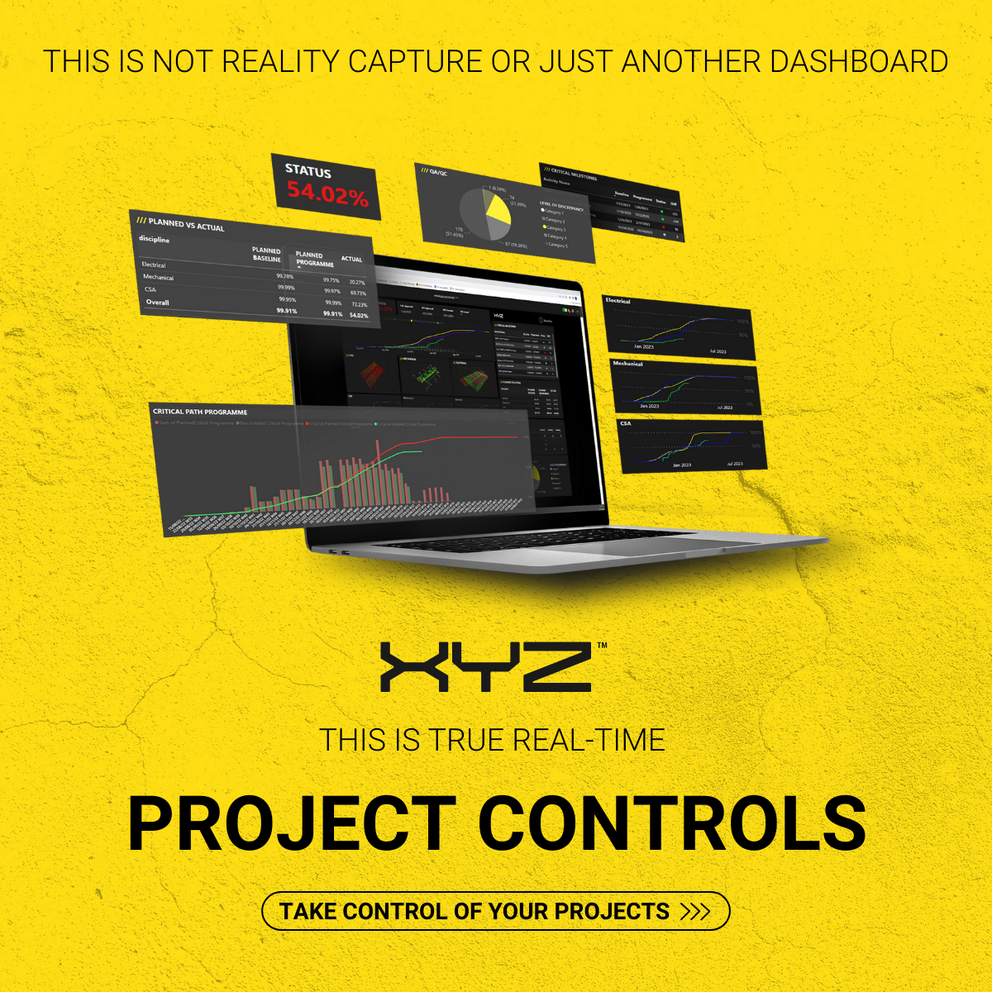-
Services
Services
Find out how we work with our clients and deliver value to construction projects from day one
-
Solutions
Solutions
Discover how all our solutions sync together to deliver construction's most powerful BIM platform to date
-
Built for
Built for
-
Industry
Industry
Understand how we support construction's biggest sectors, and hear from our clients who have experienced the power of XYZ
-
Resources
Resources
Get stuck into all our latest thought leadership, news, reports and industry leading content
-
Company
Company
Dive into what makes XYZ tick, unearth why construction is in our DNA and why we are world leaders in AR solutions

Insights
Data Center Rundown: August

28 August 2024
Another month, another data center rundown. Before I head off on holiday (and finish packing!), I’ve packed in some of this month’s key highlights. Take a moment to unwind and stay informed with the latest developments in the data center industry.
What to expect:
- Meta capex hits $8.5bn
- AWS capex set to sore
- Intel announces losses and layoffs
- Nvidia GPUs delayed
- Hyperscalers continue growth
- And much more!
Let’s dive into August’s Data Center Rundown.
Meta capex hits $8.5bn, driven by AI servers and data centers
Capital expenditure (Capex) news hit the headlines this month, starting with Meta revealing its Capex reached $8.5 billion, driven by investments in AI servers and data centers. The company expects these costs to grow significantly in 2025 as it continues to build out its AI infrastructure.
Although Capex was lower than some analysts' predictions, Meta is focusing on strategic development across various data center phases to manage spending. CEO Mark Zuckerberg emphasized the need for early capacity building to meet future AI demands, noting that future AI models will require substantially more computational power.
More Capex news, this time from AWS
In Q2 2024, Amazon Web Services (AWS) reported $26.3bn in revenue, marking an 18.8% increase from the previous year.
For Capex, Amazon invested $30.5bn in infrastructure during the first half of the year. This follows a total Capex of $48.4bn for the entire previous year, with 2024 projected to exceed that amount.
Brian Olsavsky, Amazon's Senior Vice President and CFO noted that capital investments are expected to rise in the latter half of 2024. He emphasized that the majority of this spending will focus on expanding AWS infrastructure to meet the strong demand for both generative AI and other AI workloads.
Intel announces $1.6bn net loss for Q2 2024; plans more than 15,000 layoffs
At the start of the month, Intel announced plans to cut over 15,000 jobs and implement a $10bn cost-saving strategy following a $1.6bn net loss for Q2 2024. The plan includes reducing R&D and marketing spending, cutting capital expenditures by 20%, and lowering non-variable costs by $1bn in 2025.
CEO Pat Gelsinger emphasized the need for these significant changes to align costs with the new operating model and address underperformance in revenue and AI adoption. CFO David Zinsner expects modest growth in data center demand in the latter half of the year, with increased AI-related growth in 2025.
Additionally, Intel is offering voluntary redundancy packages to employees at its Leixlip, Ireland, manufacturing sites.
Nvidia delays release of Blackwell GPUs
Adding to this month's challenges, it's reported that Nvidia is facing a delay in the release of its Blackwell GPUs, disrupting plans for hyperscale data center operators. This postponement impacts the deployment of advanced infrastructure and could slow the adoption of cutting-edge AI and high-performance computing solutions.
This delay is particularly significant for major tech players heavily invested in Nvidia’s GPUs amid an AI arms race. Google has placed an order for over 400,000 GB200 chips, valued at more than $10bn. Meta also has a $10bn order, while Microsoft had anticipated having 55,000-65,000 GB200 GPUs ready for OpenAI by the first quarter—a timeline now in question. The setback may influence the strategies and operations of these companies, which rely heavily on these GPUs for their data center needs.
APAC data centers predicted to reach 94.4GW by 2028
The APAC region is heating up in the data center sector, with IDC forecasting that installed IT power capacity will reach 94.4 GW by 2028. This projection, which excludes Japan, indicates a robust five-year compound annual growth rate (CAGR) of 14.2%.
IDC's report highlights a 9.6% year-over-year (YoY) increase in data center IT power capacity spending, with expectations for the growth rate to accelerate to 18.3% in 2024. This surge is attributed to the rise of hyperscale data centers, ongoing infrastructure modernization, and the expanding influence of AI.
"Digital transformation and generative AI are driving unprecedented growth and technological advancements in the Asia/Pacific region," said Mikhail Jaura, Senior Research Analyst for Data Center Research at IDC Asia/Pacific.
Hyperscalers lead the way
Hyperscale data centers now represent 41% of global data center capacity, according to Synergy Research Group. The number of large data centers operated by hyperscalers has surpassed 1,000, with more than half of their capacity in owned facilities and the rest in leased spaces.
Non-hyperscale colocation centers account for 22% of capacity, leaving on-premise data centers with just 37%. This is a sharp decline from six years ago when on-premise facilities held nearly 60% of the total capacity.
By 2029, hyperscale operators are expected to control over 60% of capacity, while on-premise will drop to 20%. Despite the shift, the total capacity of all data centers will grow rapidly, driven by hyperscale expansion and steady increases in colocation capacity.
John Dinsdale, Chief Analyst at Synergy Research Group, noted that regional variations exist, with hyperscale data centers being more prevalent in the US compared to Europe and APAC. He attributed the trends to the shift in enterprise spending from on-premise infrastructure to cloud services, the growth of SaaS and digital services, and the rise of generative AI, which favors hyperscale operators.
Greenlight for 386MW data center campus in Lincolnshire, UK
A new data center campus in Lincolnshire, UK, has been approved with a total capacity of 386MW. This project is set to significantly expand data processing and storage capabilities in the region, contributing to the growth of digital infrastructure and supporting the increasing demand for data services.
The project is also likely to create numerous jobs and stimulate local economic growth. Additionally, the development reflects ongoing trends in expanding data center capacity outside of traditional tech hubs, which can help distribute infrastructure more evenly across the country and potentially lower operational costs.
Equinix plans sixth Hong Kong data center
Equinix plans to build its sixth data center in Hong Kong. The new facility, named HK6, will expand the company’s data center footprint in the region to meet growing demand for digital infrastructure. This expansion is part of Equinix's broader strategy to enhance its presence in key global markets and support increased connectivity and data needs.
Yondr gets green light for third data center at Slough, UK, campus
Yondr has received planning permission for its third data center at its Slough campus in the UK. Known as Building C, the planning documents suggest a 40MW, 25,100 sqm (270,175 sq ft) building comprising four data halls over two stories. This expansion will increase Yondr’s data center capacity at the site, supporting the growing demand for digital infrastructure and connectivity in the region.
Google's Dublin data center proposal rejected due to electricity supply constraints
South Dublin County Council has denied Google Ireland planning permission for a new data center at Grange Castle Business Park in south Dublin.
The proposed development, which would have expanded an existing campus with a new 72,400 square meter facility featuring eight data halls on a 50-acre site, was rejected due to concerns over the insufficient capacity of the local electricity grid and the lack of significant on-site renewable energy to power the data center.
Look out for the next edition in September while I enjoy the rest of the summer sun! In the meantime, explore our regularly updated content at our resources hub – our exciting new case study will be available then. See you soon!








